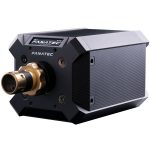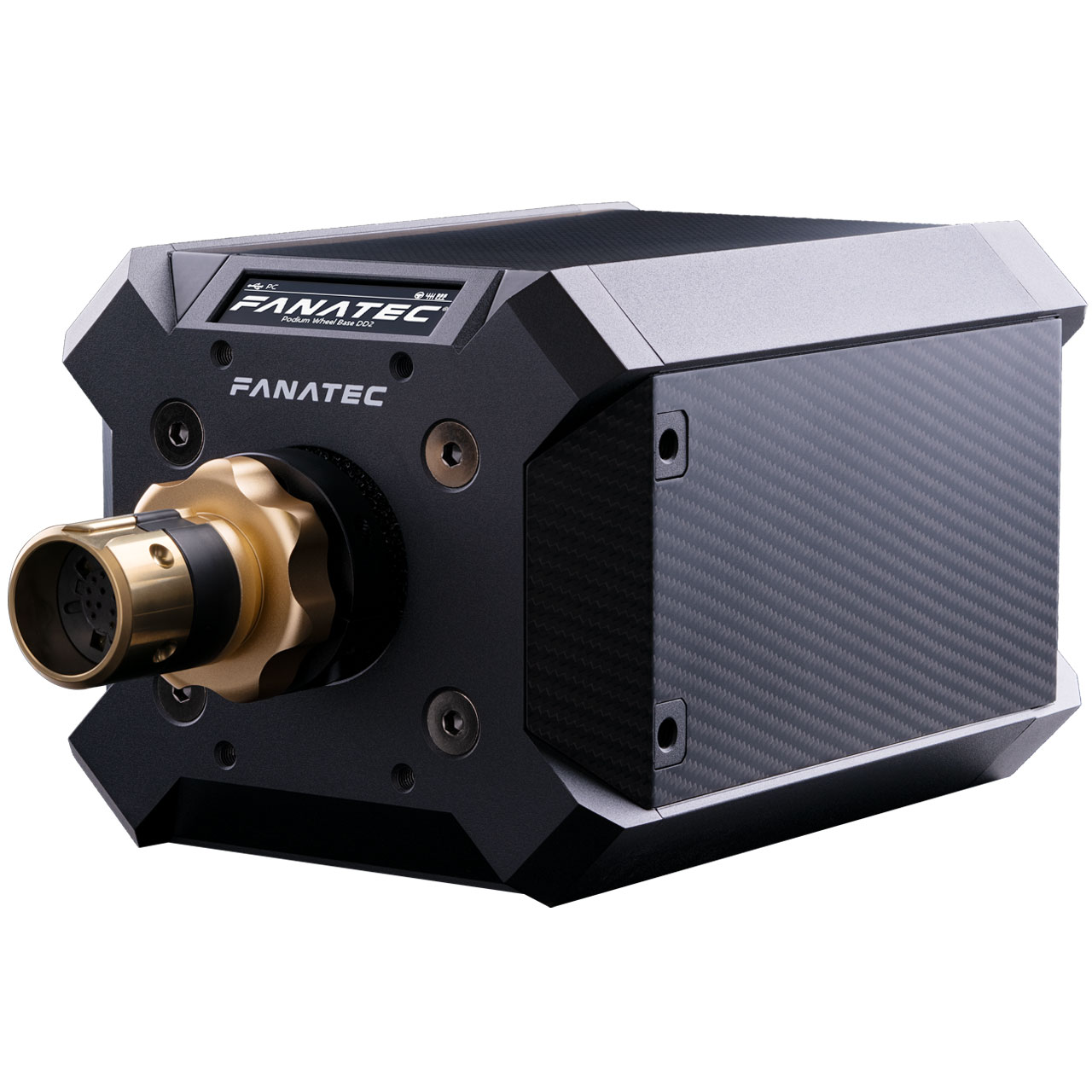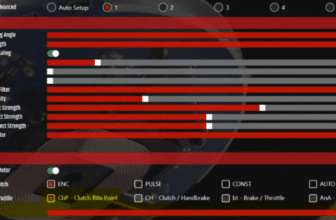For many,the Fanatec DD2 Direct Drive base represents the pinnacle of console-compatible simracing. The German brand has finally decided to restock this iconic model, and we’ve taken the opportunity to take a detailed look at Fanatec’s top-of-the-range model!
With a price tag of almost €1,500, we have to wonder whether the investment is really worth it. After all, the market for Direct Drive bases has grown enormously since 2020, with models accessible to the general public. The Fanatec CSL DD, for example, costs between €350 and €500, depending on the options chosen. Or the Moza Racing R9, also priced under 500€.
So, will the Fanatec DD2 really give you value for money? Let’s find out!
The Fanatec DD2 from a technical point of view
- Compatibility: PC, X Box Series
- Dimensions: 51 x 26 x 28 cm
- Motor: Direct Drive
- Torque: 25Nm
- Turning range: Theoretically unlimited (electronically limited to 2520° and adjustable via Fanalab)
- Connections: 1 power supply, 1 data output, 1 Kill switch (emergency stop), 1 USB output to PC, 1 connector for unbridling motor power, 2 outputs for shifters, 1 output for crankset, 1 output for handbrake, 1 CAN output
- Wheel mounting: Quick Release
- OLED display: 2.7”
- Weight: 7.4Kg
Design and ergonomics
“No, no, it’s heavy! That was our first reaction when we took the base out of the box. More than 7 Kg is a lot of muscle, but above all it requires a solid, reliable and very rigid cockpit to cope with its weight and 25Nm of torque. In the box you’ll find :
- Fanatec DD2 base
- An engine unlocking key
- Kill Switch and cable
- Power supply unit
- USB cable
I don’t know if it’s an oversight in my box, but I couldn’t find any M6 screws inside to fix the base to my chassis. Well, I’ve got some in stock, but I can imagine how frustrating it can be for a new driver to unpack his DD2 only to find that he’ll have to go shopping to install it!
The base itself is very well finished, the carbon finish is beautiful and everything is assembled with care. Note that the carbon plates on the sides and top are magnetized to the base. You can therefore remove them to customize your equipment.
At the rear of the base you’ll find all the connectors and the main power button (which you’ll probably never use, but I’ll come back to that). As well as the fan grill that cools the DD2 motor.
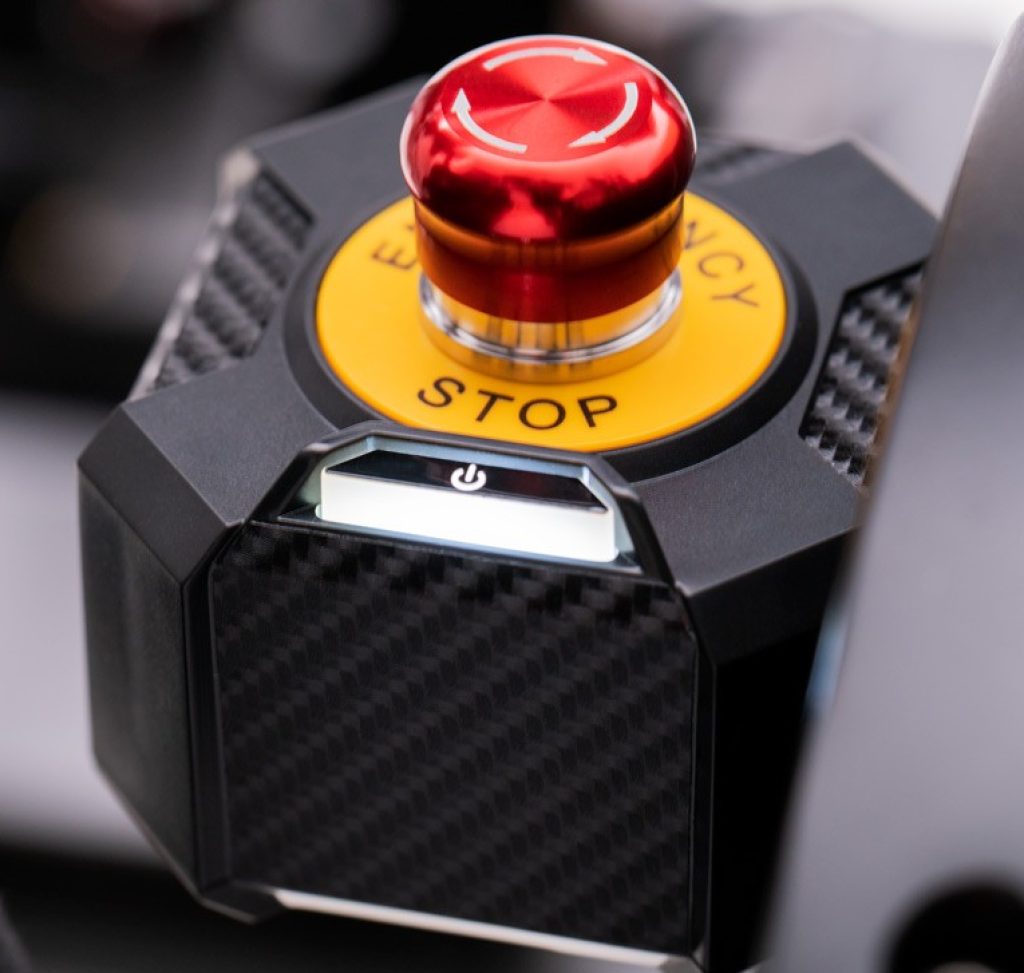
The Kill Switch consists of a plastic shell and a big red button that cuts power to the base when pressed.
To restart the base, simply turn the Kill Switch to disengage it, and press the power button just below it.
It’s this power button that you’ll most likely be using on a daily basis. After all, nobody wants to have to go and find the main power button behind the base every time 😉 M6 screw threads are provided on 3 sides of the emergency stop.
The power supply is just MASSIVE, over 53cm long, and has its own fan to keep it cool.
Installing the Fanatec DD2
OK, on to the installation on my chassis. As usual with Fanatec, there are 3 M6 screw threads under the base. Compatibility with just about every chassis on the market is, therefore, perfect. If you wish to install your Fanatec DD2 base with side brackets, this is also possible. In this case, you use the 2 screw threads on each side.
As I don’t (yet) have a way of attaching the emergency stop button near my legs, I decide to attach it to my shifter. Wherever you decide to install it, remember to keep it away from your steering wheel. You need to be able to access the emergency stop quickly and without risk of injury. The 2-meter cable supplied with the button is more than enough to install it anywhere.
Once the key has been plugged in, and the USB to my PC connected, I plug in the power supply. So far, nothing to report. I install my steering wheel using the QR1 Quick Release, and we’re ready to move on to the settings.
The Quick Release of discord
There’s one minor problem with the Quick Release. For some reason, it doesn’t seem to perform as well as the one on my CSL DD! With my Formula V2.5 wheel, I notice that there’s a bit of lateral torsion possible, as if the “male” part of the DD2 Quick Release was a tenth of a millimeter too thin.
Tightening the safety knob compresses the rubber, which is there precisely to overcome this problem. But even if it’s reduced, I still have a bit of torsion between my wheel and the steering shaft.
Fanatec steering wheels come with a safety screw that engages directly in the shaft, but once again this didn’t solve the problem.
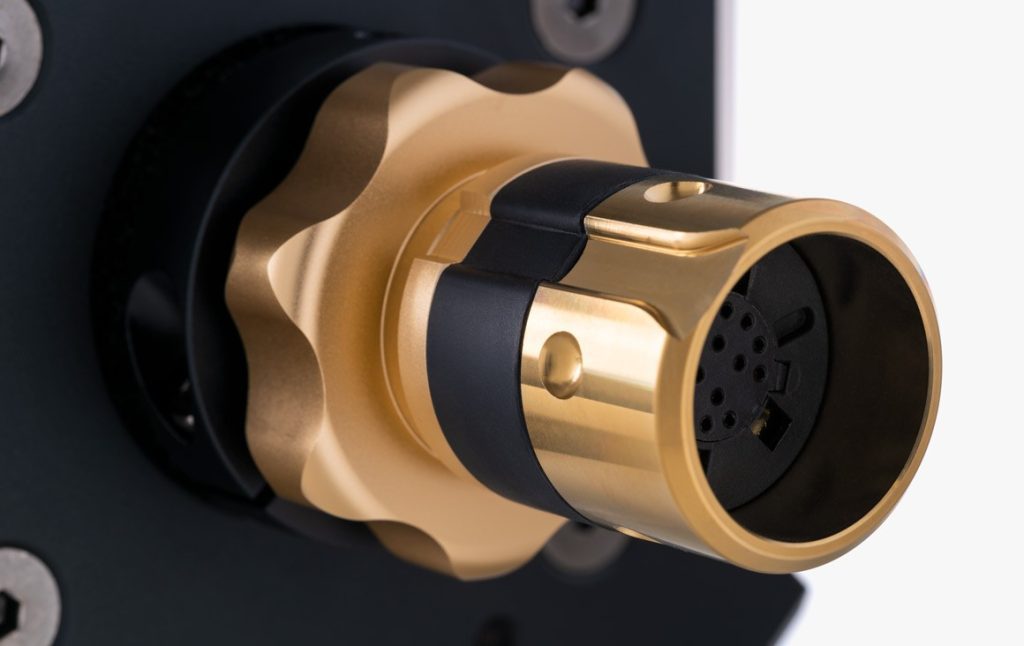
So, OK, it’s not too serious, but flexibility means losing precision on the fine details of the force feedback sent by the motor. So I can’t wait for Fanatec to finally bring out the QR2 we’ve been hearing about for years!
On to the settings in Fanalab
Once the last driver has been downloaded, it’s off to the settings in Fanalab. As always with Fanatec bases, you can create 5 different settings for different driving styles or games.
The Fanalab is designed to be very clear and intuitive, so you’ll have no trouble finding the settings that give you exactly the feel you’re looking for with your base.
In the Tuning Menu
- Degree of steering axis rotation
- Power of force feedback
- Steering wheel vibration power: if your steering wheel has vibration motors in its grips
- Brake pedal vibration force
- Accelerator pedal vibration force
- The power level of the game’s force feedback effects
- Spring effect: the force delivered by the steering wheel to refocus while racing or in the game menus
- Game damping level: controls steering wheel oscillation during races and simulates tire friction on the ground when stationary
- Natural damper: adjusts damping in addition to in-game settings
- Friction level: Adds a friction level above in-game effects
- Force feedback intensity: to make force feedback “softer” or “smoother”, or to intensify it
This menu will enable you to cut out the effects of high-speed straight-line oscillation if you have concerns in this area. Personally, I turned it off because I didn’t need it. But of course it all depends on your settings in the setup menu.
You can also adjust the damping in reverse. Once again, I’ve cut it all out, but enjoy and experiment!
This is where you can set precisely the type of vibration you want to feel. For example, vibrate the steering wheel or pedals when the engine reaches a certain rpm. Or when the ABS is triggered.
I’ve chosen to activate the steering wheel vibrations when the engine speed reaches 98%. The brake pedal when I reach 95% braking force and the gas pedal when the wheels spin.
In the LED menu, you can adjust the color and triggering events of your steering wheel LEDs. Here again, have fun with flag indicators, glide indicators, speed limiter indicators… I’ve already got an LED setting that suits me so I won’t touch it today, but know that “anything is possible” with this menu!
Finally, the Game Profile lets you save and load all the settings you want, so you can find them again in a matter of seconds. You can also export your settings to make sure you don’t lose them in the event of a problem on the Fanalab.
Comfort and feel
Let me just say that 25Nm is powerful. Very powerful. And since I’m neither a bodybuilder nor an over-trained professional rider, I chose to push the power feedback to 70%, i.e. 17.5Nm.
What’s more, the Formula V2.5 wheel is only 27cm in diameter, and mechanically, the smaller the wheel, the more intensely the force feedback power is felt in the arms. I always increase the power of the force feedback by 5 to 7% when I switch to a 30 or 32cm diameter round wheel.
The aim is not to have to fight with the steering wheel all the way through the race, but to have precisely all the details of the force feedback to feel fully connected to the car and the road. I want to feel that the virtual car I’m driving is “alive”.
This is where having a good margin of power on the Fanatec DD2 base makes itself most useful. Giving me all the details, enough power for immersion without ever reaching the point of clipping.
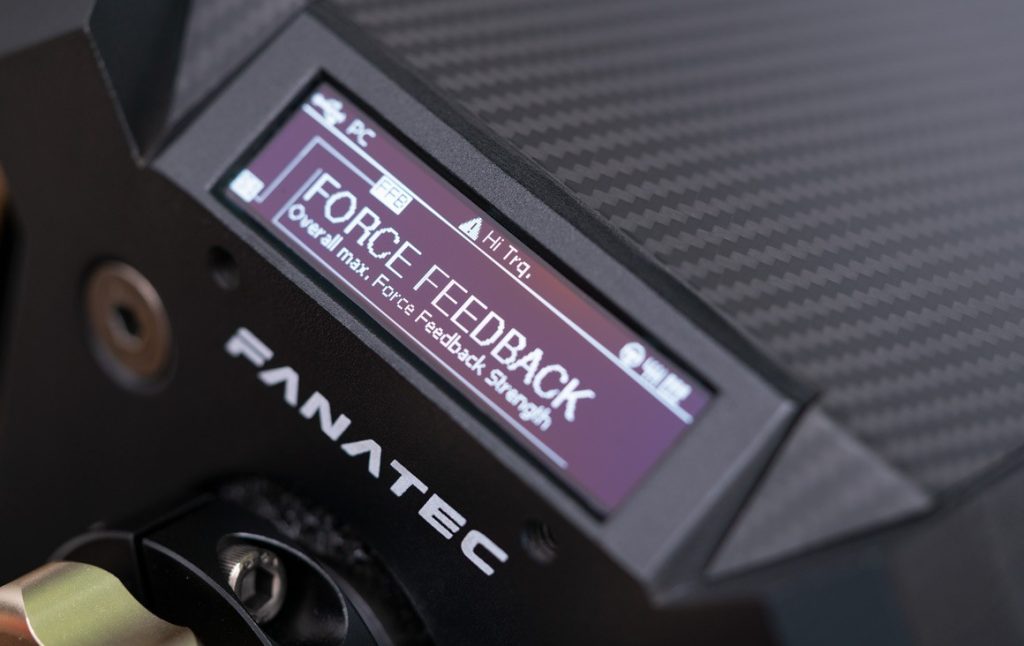
The Fanatec DD2’s large OLED screen makes it easy to scroll through the settings when making force feedback adjustments on the run. That’s a big plus compared to the simple little screens found on wheels like the V2.5. So there’s no need to switch from game to Fanalab all the time.
Thanks to the screen, you also have access to all the information on the base engine in real time.
There’s no such thing as objectivity in force feedback
Once the setup has been fine-tuned, the feel at the wheel lives up to my expectations. You can feel every bump, every change in track surface and every force applied to the car. In short, this is exactly what you want from a Direct Drive base. Precision, fidelity and maximum racing immersion .
Of course, the feeling of force feedback is perfectly and totally subjective. Everyone will have different expectations and opinions. When you add in the multiple possible settings, you realize that it’s very complicated to be objective on the subject. In any case, for me who’s used to entry-level Direct Drives like the CSL DD, the Simagic Alpha Mini or the Moza Racing R9, I have to admit that the Fanatec DD2 is another world.
Yes, it costs 3 times the price of an entry-level Direct Drive, but in concrete terms, the power and precision of the force feedback is far superior to these models.
The Fanatec ecosystem
Choosing a Fanatec DD2 also means opening up to the entire Fanatec ecosystem. The brand offers a plethora of steering wheels to suit all budgets, but of course when you have a top-of-the-range base, you don’t want to install a low-cost wheel on it. The Clubsport and Podium ranges are therefore must-haves if you want to enjoy yourself in the best possible conditions.
For Formula racing fans, the Clubsport Formula V2.5 wheel will certainly catch your eye. And for GT fans, the Clubsport RS wheels are a good place to start. But if budget allows, the Podium Porsche 911 GT3 R wheels are just sublime.
Onthe other hand, if you want to take full advantage of the DD2’s power, avoid fitting steering wheel wheels equipped with Quick Release Light (the plastic version). If you do, the base will automatically switch to clamped mode to prevent the Quick Release from exploding in 10 seconds 😉

And as far as cranksets are concerned, if you’re looking for Load Cell brakes, what better than a Fanatec Clubsport V3 or V3 Inverted to complete your setup?
Of course, you don’t have to use the Fanatec ecosystem, especially if you’re a PC gamer… You can choose to install another steering wheel using a universal adapter and another crankset connected directly to your PC or console.
The question of durability
On this point, Fanatec has every confidence in its product. That’s why the brand offers a 5-year warranty on the DD2. And apart from the Quick Release rubber, which might need replacing after a few years, the build quality suggests that the base is virtually indestructible.
But what are the differences between the Fanatec DD2 and the DD1?
To give you a quick overview of the differences between the Fanatec DD2 and the DD1, I’ve put together a little comparison chart.
| Caractéristique | Fanatec DD1 | Fanatec DD2 |
|---|---|---|
| Couple | 20Nm | 25Nm |
| Finition | Aluminium | Carbone |
| Arrêt d'urgence | Non | Oui |
| Garantie | 3 ans | 5 ans |
| Prix | 1200€ | 1500€ |
My verdict on the Fanatec DD2
The Fanatec DD2 is an excellent high-end base. In terms of power and feel, it’s clearly good value for money.
However, the budget will leave a lot of simracers out in the cold. Fortunately, now almost everyone can afford a Direct Drive, thanks to the excellent CSL DD for example.
- Successful design and perfect finish
- Very quiet fans
- Torque/Price Ratio
- Large OLED screen
- Fanalab software is intuitive and easy to use
- The Quick Release system is not yet perfect
- Price far from being accessible to all simracers

